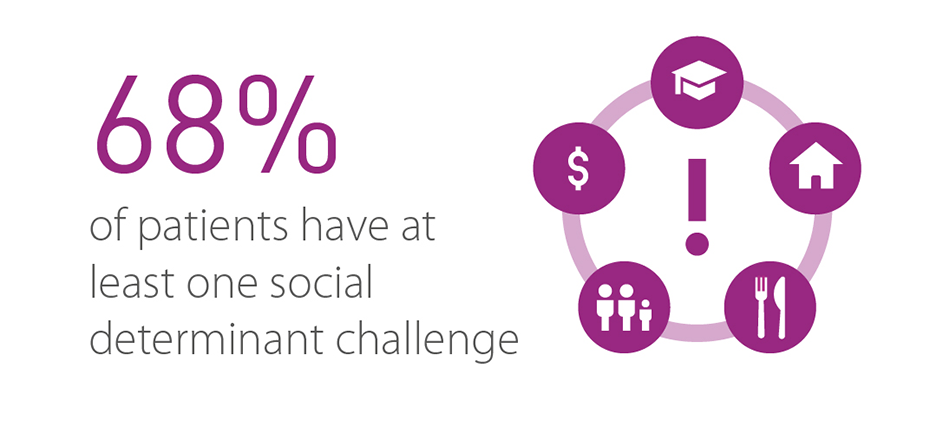
What if you could flag patients who are at risk of readmission? What if you could anticipate missed appointments or know ahead of time that someone is going to face challenges with their care plan? This knowledge could help you improve patient outcomes, streamline staff workflows and improve your bottom line.
So how can you get this non-medical information and use it to improve treatment outcomes?
A person’s circumstances can help us understand potential challenges in access to care to predict their behaviors
More than 80% of health outcomes are unrelated to medical care. Instead, they are attributable to outside social and economic forces, such as housing, education, unemployment, low income, transportation, access to green space, loneliness, inequality and other non-medical factors.
These social determinants of health (SDOH) are the living and working conditions that come together in just the right combination to either promote or a limit a person’s health and wellbeing.
As a healthcare professional, you’re no doubt aware that people struggling with financial or life circumstances have a more difficult time focusing on their health and subsequently face more urgent hardships. And it isn’t just the patients who suffer. It has a negative impact on the entire healthcare ecosystem.
Why providers should care about social determinants of health
When patients struggle to access healthcare services, they’re less likely to follow treatment plans or adhere to follow-up visits. They’re more likely to need to come back with more serious conditions that could have been detected earlier, had they felt equipped to follow the care plan. Not only is this worrying for the patient, but it also leads to excessive service utilization that is costly for providers.
Missed appointments are estimated to cost the US healthcare system a massive $150 billion, while each unused 60-minute slot costs an average of $200. And that’s not to mention the opportunity cost of equipment and rooms sitting idle, and all those wasted hours of billable physician time.
The shift to value-based care puts more pressure on providers to improve outcomes. But how can they do that when those outcomes are partially determined by factors beyond their control? Considering that 68% of patients have at least one social determinant challenge, the only sensible move is to bring solving for SDOH to the forefront of care planning.
“No patient wants to skip appointments and dial 911 as their only reliable means to get the care they need,” said Karly Rowe, Experian Health vice president of product management. “We want to level the playing field by helping providers identify and solve for these socio-economic challenges that make it hard for some patients to get the care they need. SDOH has the ability to improve outcomes, lower costs and increase patient satisfaction, removing the socio-economic obstacles hindering healthcare.”
An example of providers and payers collaborating to solve for social determinants of health is the Aligning for Health coalition, which in 2016 referred 33,000 patients to community initiatives.
Andy Friedell, a senior vice president at Maxim Healthcare Services said of the program: “We are prioritizing community-based care and social determinant solutions for our patients and clients. In fact, we have effectively used these tools to help reduce readmissions by over 65% for high-risk patients.”
How can social determinant data improve outcomes?
Let’s look at two examples of how healthcare providers might analyze social determinants to help improve care management.
1. Reducing appointment no-shows
For many patients, a lack of transportation is the main barrier to compliance. How do they get to an appointment or procedure if they don’t have a car, don’t live in an area well served by public transport, and can’t afford a cab?
Looking at vehicle registration data and public transport services in the area would be one way for a provider to gauge access to care. But does that give the full story? Even if they can find transport, are they juggling two jobs? Do they need childcare?
By synthesizing data on transportation, family arrangements, average incomes, and more, providers can anticipate the propensity of someone being unable to access care, and offer solutions such as a free hospital bus service or crèche facility.
2. Preventing escalated health conditions
Understanding social determinants is not about identifying unhealthy behavior. For example, a provider might see poor health and point to poor diet. But a patient’s poor diet may not simply result from poor choices.
A provider who’s aware of the potential impact of social determinants might consider the propensity of food insecurity – maybe the patient doesn’t have access to healthy food? However, putting the patient at the center and truly understanding social determinants means thinking beyond the ‘food desert’ explanation.
Even where healthy food is available, the ability to eat it might be limited by lack of time to cook it, or money to buy it. The provider must adjust their lens and understand how a stressful work schedule, chaotic household and readily available cheap food converge to make it virtually impossible for the patient to even think about putting their health first with a healthy meal. As a result, a patient who could have been identified early on with symptoms indicating the onset of diabetes, for example, instead has their diagnosis delayed because they can’t get to an appointment, while their condition worsens due to their unhealthy diet.
Instead of offering dietary advice or signposting to a wholesome supermarket, the provider might choose to work with a registered dietician nutritionist, direct patients to community resources, participate in community partnerships, or even engage with local planning departments and commercial developers.
When you understand what drives your patients and recognize the real barriers preventing them from prioritizing or accessing healthcare, you can proactively identify opportunities to solve them.
3. Using the right data to understand and solve for social determinants of health
Better care management and improved health outcomes start with understanding the whole patient and the social determinants impacting their life, and then turning those insights into actions.
For providers to be proactive, preventative and patient-friendly, they need to know the patient’s socioeconomic background before they enter the room. They must have an idea of what that conversation should look like before they even say hello, and know which SDOH-related programs might be relevant to this patient.
Analytics platforms can help leverage wider consumer data sets to spot patterns that affect operational efficiencies so providers can offer more patient-centered care.
Of course, if you’re using consumer data, you must have confidence both in its accuracy and in your ability to safeguard consumer privacy. Both can be achieved if you work with a data management partner who can collect data from consumers at scale, with solutions that check all the privacy boxes necessary to allow this data to be used in a healthcare setting.
So if you weren’t already thinking about what social determinants of health mean for your organization, perhaps think about what you could do now to incorporate a solution that tells you what patients need, provides the right amount of context to understand what external factors might be causing or affecting that need, and then solve for it at the point of care.
—
The solution exists to help you. You could have the power to identify and solve for social determinants at your fingertips.



